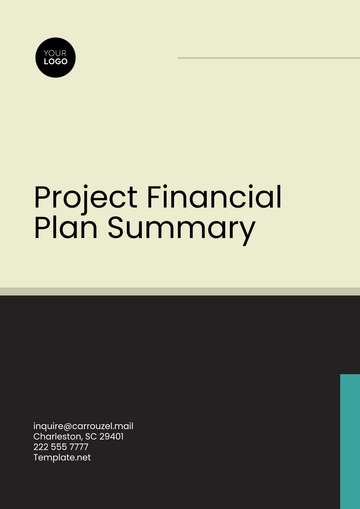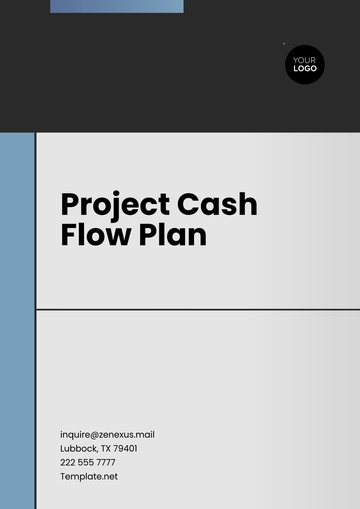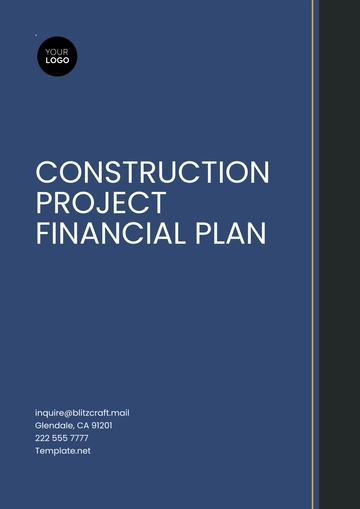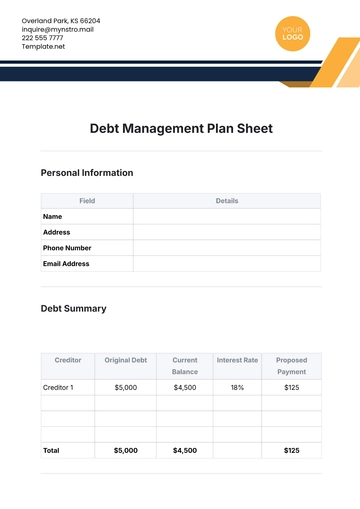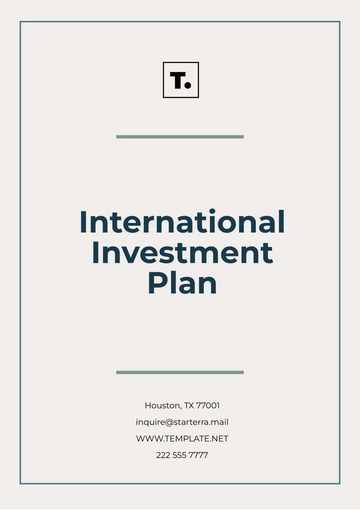Free Finance Payroll System Restructuring Plan
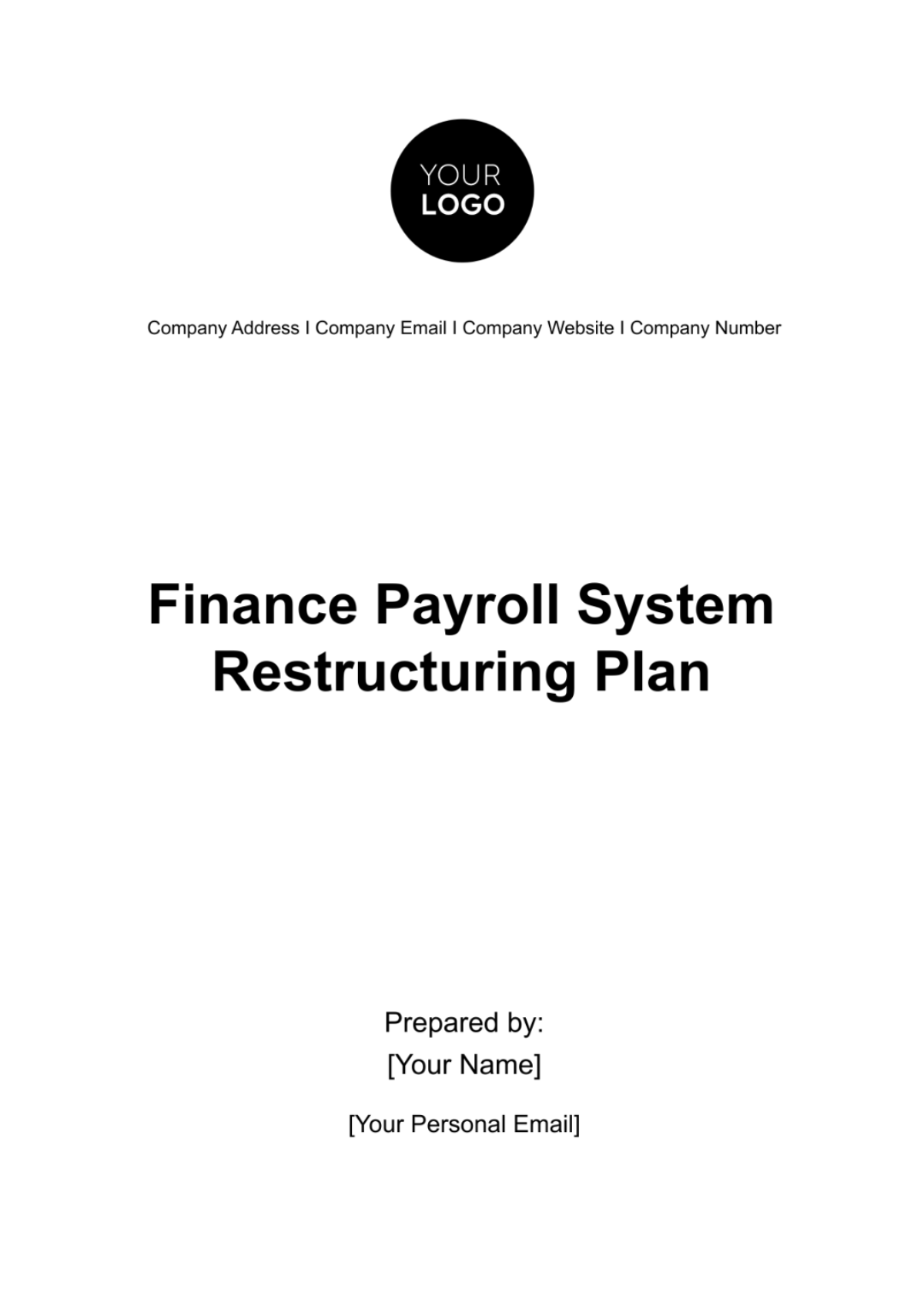
Introduction
This document presents a comprehensive plan for restructuring our organization's finance payroll system. The plan aims to address current operational challenges, optimize payroll management, and align with our strategic financial goals. This restructuring is envisioned to streamline payroll processes, ensuring efficiency, accuracy, and compliance with regulatory standards.
Purpose and Objectives
The primary purpose of this payroll restructuring plan is to enhance the effectiveness and reliability of our payroll system. The objectives include:
Reducing errors in payroll calculations and processing times.
Identifying and implementing strategies to minimize payroll-related expenses.
Ensuring our payroll system adheres to the latest legal and tax requirements.
Streamlining the payroll process to ensure timely and accurate salary disbursement, thereby improving employee morale.
Background for Adjustment
In the past year, we have observed several challenges with our current payroll system:
Inefficiency and Errors: A noticeable rate of errors in payroll calculations was observed, leading to an increased workload in rectifying these issues.
Regulatory Challenges: Recent changes in tax laws and employment regulations have made our current system less compliant, posing potential legal risks.
Cost Overruns: Analysis revealed that our payroll processing costs have exceeded the budget by 15% in the past fiscal year, indicating a need for cost-effective solutions.
Employee Feedback: Surveys conducted among employees highlighted delays and inaccuracies in salary payments, affecting overall job satisfaction.
These challenges necessitate a thorough review and adjustment of our finance payroll system to ensure it meets our operational needs, financial objectives, and the well-being of our workforce.
Current System Analysis
In this section, we conduct a thorough analysis of our existing finance payroll system. The aim is to identify key challenges and inefficiencies that have prompted the need for a comprehensive restructuring plan.
The Existing Payroll System
Our current payroll system is a hybrid model, combining manual processes with basic digital tools. Primarily, it involves manual data entry for employee hours, leaves, and other payroll variables into a basic payroll software. This software calculates gross pay, tax deductions, and net pay, but requires manual verification and adjustments. The system also includes manual generation of payslips and end-of-year tax documents. Integration with our human resources and timekeeping systems is minimal and largely manual, leading to delays and potential data discrepancies. The current system, while functional, has become increasingly cumbersome and error-prone as our organization has grown.
Challenges and Impacts
Challenge | Impact |
Manual Data Entry | High susceptibility to human error, leading to frequent inaccuracies in payroll processing. |
Limited Integration with HR Systems | Delays in data transfer and discrepancies between systems, affecting payroll accuracy. |
Inefficient Tax and Deduction Calculations | Manual updating of tax rates and deductions, increasing the risk of compliance issues. |
Lack of Real-Time Reporting and Analytics | Inability to generate timely financial reports, impacting strategic decision-making. |
High Processing Time and Labor Costs | Payroll processing is time-intensive, leading to increased operational costs. Estimated at $30,000 annually in extra labor. |
Inadequate Data Security Measures | Potential risks of data breaches and privacy violations in handling sensitive employee information. |
Restructuring Objectives
In this part of the restructuring plan, we outline the specific objectives that our finance payroll system restructuring aims to achieve. These objectives are designed to address the challenges identified in our current system and to align with our long-term organizational goals.
Specific Goals
Enhance Accuracy and Reduce Errors: By automating data entry and calculations, we aim to significantly reduce human errors in payroll processing. This will lead to more reliable and accurate payroll outcomes for both the organization and employees.
Improve Integration with HR Systems: Our goal is to establish seamless integration between payroll, HR, and timekeeping systems. This will ensure real-time data sharing and synchronization, enhancing overall payroll efficiency.
Automate Tax and Deduction Calculations: Implementing a system that automatically updates and calculates taxes and deductions will ensure compliance with changing regulations. This will mitigate the risk of legal and financial penalties due to non-compliance.
Develop Advanced Reporting and Analytics Capabilities: By integrating advanced analytics into our payroll system, we aim to provide timely and insightful financial reports. This will support better strategic decision-making and financial planning.
Optimize Operational Efficiency and Reduce Costs: Streamlining the payroll process will reduce the time and labor costs currently incurred. This optimization is expected to save approximately $20,000 annually, enhancing overall operational efficiency.
Expected Benefits
Increased Operational Efficiency: A more streamlined and automated payroll system will drastically reduce processing time and operational costs. This efficiency will enable our staff to focus on more strategic tasks, contributing to overall organizational productivity.
Enhanced Compliance and Risk Management: With automated updates and calculations, our new system will better manage compliance with tax laws and regulations. This will reduce the risk of legal issues and enhance our reputation as a responsible employer.
Improved Employee Satisfaction and Trust: Accurate and timely payroll processing will increase employee satisfaction and trust in our organization. This is crucial for maintaining a positive work environment and high levels of employee engagement.
Proposed Changes and Innovation
This section details the specific changes and technological innovations we propose to implement in our finance payroll system. These proposed modifications are designed to overcome current challenges and enhance overall payroll management efficiency.
Proposed Changes
Transition to Full Automation | Implementing a fully automated payroll system to eliminate manual data entry and reduce errors. |
Integration with HR and Timekeeping Systems | Creating seamless real-time data integration between payroll, HR, and timekeeping systems for synchronized information flow. |
Upgraded Tax Calculation Software | Introducing advanced software capable of automatically updating and calculating taxes and other deductions in compliance with current regulations. |
New Technologies
Cloud-Based Payroll Solutions | Adopting cloud-based payroll software to ensure accessibility, scalability, and enhanced security. |
Automated Reporting Tools | Integrating automated reporting and analytics tools for real-time financial insights and decision-making support. |
Employee Self-Service Portals | Implementing self-service portals for employees to access payslips, tax forms, and to update personal information, reducing administrative workload. |
Compliance Management Systems | Utilizing dedicated compliance management systems to continuously monitor and adhere to changing legal and tax obligations. |
Financial Analysis
In this section, we conduct a comprehensive financial analysis of the proposed changes to our finance payroll system. This analysis includes a cost-benefit assessment of the proposed modifications and an examination of the budgetary requirements and potential financial impact.
Cost-Benefit Analysis
Aspect of Change | Estimated Cost (Annual) | Expected Annual Savings/Benefits | Net Annual Impact |
Transition to Full Automation | $80,000 | $25,000 | $55,000 |
Integration with HR and Timekeeping | $30,000 | $15,000 | $15,000 |
Upgraded Tax Calculation Software | $25,000 | $10,000 | $15,000 |
Enhanced Data Security Measures | $15,000 | $5,000 | $10,000 |
Scalable Payroll Infrastructure | $40,000 | $10,000 | $30,000 |
The cost-benefit analysis indicates a positive net annual impact of $125,000 resulting from the proposed changes. The significant cost savings are primarily driven by the automation of manual processes, reduction in operational costs, and improved efficiency in tax calculations and compliance management.
Budgetary Requirements
Budget Item | Initial | Annual |
Initial Implementation Costs | $200,000 | - |
Annual Operating Costs (Including Savings) | - | $75,000 |
Contingency Fund | $20,000 | - |
The initial implementation will require an investment of $200,000, which includes the setup and integration of the new payroll system. The annual operating cost, considering savings from efficiency gains, is estimated at $75,000. A contingency fund of $20,000 is allocated to cover unforeseen expenses during the implementation phase.
This financial analysis demonstrates that while there is an upfront investment, the proposed changes are expected to yield substantial cost savings and benefits in the long term, ensuring a positive financial impact on our organization.
Risk Assessment and Mitigation Strategies
This section identifies potential risks associated with the implementation of the new payroll system and outlines corresponding mitigation strategies. It aims to proactively address challenges to minimize disruptions and ensure a successful transition.
Risk | Likelihood | Impact | Mitigation Strategy |
Technical Issues with New System | Medium | High | Implement a thorough testing phase during development; establish a technical support team for immediate response to issues. |
Employee Resistance to Change | Low | Medium | Conduct training sessions; provide clear communication about benefits and support during transition. |
Data Security Risks | High | High | Employ robust cybersecurity measures; regular security audits and compliance checks. |
Project Delays | Medium | Medium | Develop a detailed project timeline with buffer periods; regular progress reviews and contingency plans for delays. |
Cost Overruns | Low | High | Maintain strict budget monitoring; regular financial reviews and adjustments as necessary. |
Compliance and Legal Issues | Low | High | Engage legal experts for compliance checks; regular updates on legal and regulatory changes. |
Inaccurate Data Transfer | Medium | High | Ensure accurate data migration through validation checks; involve data specialists in the transfer process. |
Legal Compliance and Considerations
This section outlines the legal and compliance considerations relevant to our payroll system adjustments in the United States. It ensures that the proposed changes align with applicable laws and regulations, and details the procedures we will adopt to maintain compliance post-implementation.
Relevant US Laws
Fair Labor Standards Act (FLSA): The proposed system will ensure accurate tracking and compensation for overtime, adhering to FLSA requirements. Automated timekeeping will enhance compliance with minimum wage and overtime pay standards.
Internal Revenue Service (IRS) Regulations: With advanced software, we will ensure accurate tax deductions and record-keeping, in line with IRS guidelines. The system will automatically update for any changes in tax laws, ensuring ongoing compliance.
Employee Retirement Income Security Act (ERISA): The new payroll system will maintain precise records of employee benefits and retirement plans, complying with ERISA’s reporting and disclosure requirements.
Health Insurance Portability and Accountability Act (HIPAA): In handling employee health benefit information, the system will comply with HIPAA’s privacy and security rules, ensuring the confidentiality and integrity of sensitive data.
Equal Employment Opportunity (EEO) Laws: By ensuring unbiased and transparent payroll processing, the system supports compliance with EEO laws, preventing discrimination in compensation.
Compliance Post-Implementation
Staying informed on legislative changes affecting payroll and adjusting the system accordingly.
Conducting periodic audits to ensure ongoing adherence to legal standards and identifying areas for improvement.
Regular training sessions for staff to update them on compliance-related changes and system use.
Maintaining detailed records of all payroll transactions and reports for legal scrutiny and audits.
Regularly updating security measures to protect sensitive payroll data, in compliance with data protection laws.
Employee Communication and Training
This section focuses on the strategies for effectively communicating the upcoming changes to our employees and outlines the comprehensive training programs planned for staff adaptation to the new payroll system. It also presents the mechanisms we will implement to gather feedback throughout this transition process.
Employee Communication
Initial Announcement Email: An all-staff email detailing the upcoming changes, reasons for the shift, and expected benefits.
Information Sessions: Organized departmental meetings to explain the changes in detail and address immediate concerns.
Q&A Sessions: Interactive sessions for employees to ask questions and get clarifications about the new system.
Direct Line of Communication: Establishing a dedicated email and phone line for ongoing questions and support.
Staff Training Programs
Training Topic | Target Audience | Duration | Method |
Overview of New Payroll System | All Employees | 1 Hour | Webinar |
Detailed System Functionality | HR and Payroll Staff | 2 Days | In-Person Workshop |
Data Entry and Processing | Administrative Staff | 3 Hours | Online Tutorial |
Advanced Features and Reporting | Management Staff | 4 Hours | Interactive Session |
Security Protocols | IT and HR Teams | 2 Hours | Seminar |
Implementation Strategy
In this section, we outline the step-by-step implementation strategy for our finance payroll system restructuring plan. We specify the timeline for each phase, along with the responsibilities assigned to ensure a smooth and successful transition.
Step | Month | Responsibilities |
Project Initiation and Team Formation | Month 1 | Project Manager, HR Manager, IT Manager |
Needs Assessment and Requirement Gathering | Month 2-3 | HR Manager, IT Manager, Project Team |
Vendor Selection and Procurement | Month 4-5 | Procurement Team, IT Manager, Project Manager |
System Development and Configuration | Month 6-8 | IT Development Team, IT Manager, HR Manager |
Testing and Quality Assurance | Month 9-10 | Quality Assurance Team, HR Manager, IT Manager |
Training and Skill Development | Month 11 | HR Manager, Training Team, IT Manager |
Pilot Testing and Feedback Collection | Month 12 | Pilot Group, HR Manager, IT Manager |
Full-Scale Implementation | Month 13 | HR Manager, IT Manager, Project Team |
Monitoring and Continuous Improvement | Ongoing | HR Manager, IT Manager, Quality Assurance Team |
Evaluation and Feedback Mechanisms
In this section, we outline the criteria and methods for evaluating the success of our finance payroll system restructuring plan. Additionally, we describe the processes we will implement for collecting and responding to feedback throughout and after the implementation phase.
Criteria for Evaluation | Evaluation Methodology |
Accuracy and Error Reduction | Regular audits and error tracking |
Integration Efficiency | Monitoring data synchronization |
Compliance with Tax Regulations | Compliance audits and reporting |
Operational Efficiency | Monitoring processing times and costs |
Employee Satisfaction and Feedback | Surveys and feedback collection |
Financial Impact Assessment | Cost-benefit analysis and budget reviews |
Data Security and Privacy Compliance | Security audits and compliance checks |
Processes
Regular Surveys: Conducting surveys to gather feedback from employees regarding their experiences with the new payroll system.
Feedback Hotline: Establishing a dedicated channel for employees to report issues, ask questions, or provide suggestions.
Post-Implementation Reviews: Holding regular meetings with project stakeholders to review progress and address concerns.
Quality Assurance Checks: Continuously monitoring data accuracy and system performance to proactively identify and address any issues.
Feedback Incorporation: Responsively integrating feedback into ongoing system improvements and updates.
- 100% Customizable, free editor
- Access 1 Million+ Templates, photo’s & graphics
- Download or share as a template
- Click and replace photos, graphics, text, backgrounds
- Resize, crop, AI write & more
- Access advanced editor
The Finance Payroll System Restructuring Plan Template from Template.net is invaluable for reorganizing payroll processes. Editable and customizable in our AI Editor tool, this template provides a comprehensive framework for planning and implementing changes in the payroll system. It ensures a structured approach to enhance efficiency and accuracy in payroll management, suitable for any business seeking to optimize its financial operations.
You may also like
- Finance Plan
- Construction Plan
- Sales Plan
- Development Plan
- Career Plan
- Budget Plan
- HR Plan
- Education Plan
- Transition Plan
- Work Plan
- Training Plan
- Communication Plan
- Operation Plan
- Health And Safety Plan
- Strategy Plan
- Professional Development Plan
- Advertising Plan
- Risk Management Plan
- Restaurant Plan
- School Plan
- Nursing Home Patient Care Plan
- Nursing Care Plan
- Plan Event
- Startup Plan
- Social Media Plan
- Staffing Plan
- Annual Plan
- Content Plan
- Payment Plan
- Implementation Plan
- Hotel Plan
- Workout Plan
- Accounting Plan
- Campaign Plan
- Essay Plan
- 30 60 90 Day Plan
- Research Plan
- Recruitment Plan
- 90 Day Plan
- Quarterly Plan
- Emergency Plan
- 5 Year Plan
- Gym Plan
- Personal Plan
- IT and Software Plan
- Treatment Plan
- Real Estate Plan
- Law Firm Plan
- Healthcare Plan
- Improvement Plan
- Media Plan
- 5 Year Business Plan
- Learning Plan
- Marketing Campaign Plan
- Travel Agency Plan
- Cleaning Services Plan
- Interior Design Plan
- Performance Plan
- PR Plan
- Birth Plan
- Life Plan
- SEO Plan
- Disaster Recovery Plan
- Continuity Plan
- Launch Plan
- Legal Plan
- Behavior Plan
- Performance Improvement Plan
- Salon Plan
- Security Plan
- Security Management Plan
- Employee Development Plan
- Quality Plan
- Service Improvement Plan
- Growth Plan
- Incident Response Plan
- Basketball Plan
- Emergency Action Plan
- Product Launch Plan
- Spa Plan
- Employee Training Plan
- Data Analysis Plan
- Employee Action Plan
- Territory Plan
- Audit Plan
- Classroom Plan
- Activity Plan
- Parenting Plan
- Care Plan
- Project Execution Plan
- Exercise Plan
- Internship Plan
- Software Development Plan
- Continuous Improvement Plan
- Leave Plan
- 90 Day Sales Plan
- Advertising Agency Plan
- Employee Transition Plan
- Smart Action Plan
- Workplace Safety Plan
- Behavior Change Plan
- Contingency Plan
- Continuity of Operations Plan
- Health Plan
- Quality Control Plan
- Self Plan
- Sports Development Plan
- Change Management Plan
- Ecommerce Plan
- Personal Financial Plan
- Process Improvement Plan
- 30-60-90 Day Sales Plan
- Crisis Management Plan
- Engagement Plan
- Execution Plan
- Pandemic Plan
- Quality Assurance Plan
- Service Continuity Plan
- Agile Project Plan
- Fundraising Plan
- Job Transition Plan
- Asset Maintenance Plan
- Maintenance Plan
- Software Test Plan
- Staff Training and Development Plan
- 3 Year Plan
- Brand Activation Plan
- Release Plan
- Resource Plan
- Risk Mitigation Plan
- Teacher Plan
- 30 60 90 Day Plan for New Manager
- Food Safety Plan
- Food Truck Plan
- Hiring Plan
- Quality Management Plan
- Wellness Plan
- Behavior Intervention Plan
- Bonus Plan
- Investment Plan
- Maternity Leave Plan
- Pandemic Response Plan
- Succession Planning
- Coaching Plan
- Configuration Management Plan
- Remote Work Plan
- Self Care Plan
- Teaching Plan
- 100-Day Plan
- HACCP Plan
- Student Plan
- Sustainability Plan
- 30 60 90 Day Plan for Interview
- Access Plan
- Site Specific Safety Plan

